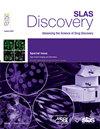High throughput screening for SARS-CoV-2 inhibitors targeting 5 helix bundle
IF 2.7
4区 生物学
Q2 BIOCHEMICAL RESEARCH METHODS
引用次数: 0
Abstract
SARS-CoV-2 and other related viruses enter host cells via receptor recognition and membrane fusion. A crucial part of this is mediated by 5HB which is capable of binding to the viral spike heptad repeats (HR2) making 5HB a potential druggable target of virus entry. Thus, we constructed a 5-Helix Bundle (5HB) pentamer assay for the purpose of identifying potential inhibitors SARS-CoV-2 virus entry. Following implementation and optimization into a 1536 well format, we validated this assay via a pilot HTS and proved we were able to find small molecule inhibitors that appear to compete with the 5HB binding to HR2. This allowed us to push forward and complete the full HTS campaign testing 635,262 compounds. Upon completion of the 5HB pentamer HTS, we also tested and validated a monomer version of the 5HB assay against a pilot screen and then used it to help confirm on-target activity. This allowed for the selection of 130 compounds which were tested in dose titration format against the 5HB pentamer assay. The same compounds were tested in secondary cell-based assays for SARS2 and Machupo virus entry via a dual luciferase transient transfection system. We also incorporated a live/dead cytotoxicity counterscreen. At the conclusion of these screens, 41 compounds were found to be selective inhibitors of the 5HB pentamer assay. From these assays, 31 compounds and analogs were selected which were tested in both the pentamer and monomer assays. 5 compounds emerged which showed good potency in both assays which were then tested in the SARS pseudo virus assay to round out this exercise.
靶向5螺旋束的SARS-CoV-2抑制剂的高通量筛选
SARS-CoV-2等相关病毒通过受体识别和膜融合进入宿主细胞。其中一个关键部分是由5HB介导的,它能够与病毒尖峰七磷酸重复序列(HR2)结合,使5HB成为病毒进入的潜在药物靶标。因此,我们构建了一个5-Helix Bundle (5HB)五聚体实验,目的是鉴定潜在的SARS-CoV-2病毒进入抑制剂。在1536孔格式的实施和优化之后,我们通过试点HTS验证了该试验,并证明我们能够找到与5HB结合HR2竞争的小分子抑制剂。这使我们能够推进并完成完整的HTS活动,测试635,262种化合物。在完成5HB五聚体HTS后,我们还在试点筛选中测试和验证了5HB的单体版本,然后使用它来帮助确认靶标活性。这允许选择130种化合物,以剂量滴定形式对5HB五聚体测定进行测试。通过双荧光素酶瞬时转染系统,对相同的化合物进行了SARS2和Machupo病毒进入的二级细胞检测。我们还加入了活/死细胞毒性反筛。在这些筛选的结论中,发现41种化合物是5HB五聚体测定的选择性抑制剂。从这些分析中,选择了31个化合物和类似物,并在五聚体和单体分析中进行了测试。出现了5种化合物,它们在两种检测中都表现出良好的效力,然后在SARS伪病毒检测中进行了测试,以完成这项工作。
本文章由计算机程序翻译,如有差异,请以英文原文为准。
求助全文
约1分钟内获得全文
求助全文
来源期刊

SLAS Discovery
Chemistry-Analytical Chemistry
CiteScore
7.00
自引率
3.20%
发文量
58
审稿时长
39 days
期刊介绍:
Advancing Life Sciences R&D: SLAS Discovery reports how scientists develop and utilize novel technologies and/or approaches to provide and characterize chemical and biological tools to understand and treat human disease.
SLAS Discovery is a peer-reviewed journal that publishes scientific reports that enable and improve target validation, evaluate current drug discovery technologies, provide novel research tools, and incorporate research approaches that enhance depth of knowledge and drug discovery success.
SLAS Discovery emphasizes scientific and technical advances in target identification/validation (including chemical probes, RNA silencing, gene editing technologies); biomarker discovery; assay development; virtual, medium- or high-throughput screening (biochemical and biological, biophysical, phenotypic, toxicological, ADME); lead generation/optimization; chemical biology; and informatics (data analysis, image analysis, statistics, bio- and chemo-informatics). Review articles on target biology, new paradigms in drug discovery and advances in drug discovery technologies.
SLAS Discovery is of particular interest to those involved in analytical chemistry, applied microbiology, automation, biochemistry, bioengineering, biomedical optics, biotechnology, bioinformatics, cell biology, DNA science and technology, genetics, information technology, medicinal chemistry, molecular biology, natural products chemistry, organic chemistry, pharmacology, spectroscopy, and toxicology.
SLAS Discovery is a member of the Committee on Publication Ethics (COPE) and was published previously (1996-2016) as the Journal of Biomolecular Screening (JBS).
 求助内容:
求助内容: 应助结果提醒方式:
应助结果提醒方式:


